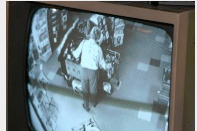 Shoplifters are great. Well, not great for business, but great for laughs sometimes. Most of the times, shoplifting incidents are pretty serious business. You’re confronting someone who has just committed a crime. You don’t know their state of mind and you definitely don’t know what they are capable of. I’ve personally been pepper sprayed by a shoplifter as they tried to escape, along with seeing countless managers suffer the same fate. Often suspects immediately want to become physical and more simply will flee the store. Every now and then karma and a little luck is on your side.
Shoplifters are great. Well, not great for business, but great for laughs sometimes. Most of the times, shoplifting incidents are pretty serious business. You’re confronting someone who has just committed a crime. You don’t know their state of mind and you definitely don’t know what they are capable of. I’ve personally been pepper sprayed by a shoplifter as they tried to escape, along with seeing countless managers suffer the same fate. Often suspects immediately want to become physical and more simply will flee the store. Every now and then karma and a little luck is on your side.
I was training a new LP agent last summer in a very active market. It was day four of our training and she had already thrown a half dozen folks in jail. So far, no problems, this particular agent was an attractive young female who didn’t take lip from ANYONE! It was amazing how many shoplifters hit on her… but we’ll save those stories for another time. The clock was ticking away and it was just about time to call it a night when one of our frequent flyers entered the store. I had busted this guy on no less than three previous thefts and he was definitely a runner. I had my new agent begin observation while I contacted the police. At the very least, I was going to charge him with trespassing.
About 15 minutes goes by and like always, the shoplifter starts loading his pants up with electronics. About this time, the police were arriving, so I went outside to inform them of the situation and wait for the thief and my agent to exit the store. Well, she didn’t disappoint. Our thief exits, but completely ignores the agent and takes off running. The next thing I know he’s gone. He’s hiding around the vehicles in the parking lot, but we can’t seem to find him. The officer gets on his loudspeaker and announces that he’s going to let the K-9 unit loose if he doesn’t turn himself in. No answer.
Standing a full 3.5 feet tall and weighing in at about 120 pounds, K-9 Officer Scout is ready for action. This is a game for the pooch and I can tell he’s ready to play. Within seconds of jumping out of the patrol car, he and his handler are on the scent. Like a scene from a movie, out of nowhere, the shoplifter emerges. Only… he doesn’t surrender. In true idiot fashion, he starts sprinting across the parking lot. I don’t care how fast you think you are; you will never outrun a German shepherd whose sole purpose in life is to take you down. And take him down he did. When the handler finally reached the scene the shoplifter had a knife he was trying to stab the K-9 officer with. Not only did this shoplifter go to jail with some pretty serious bite wounds, he also got to feel what 100,000 volts of electricity from a Taser felt like.






